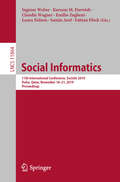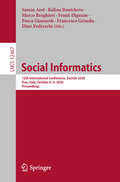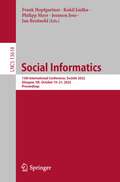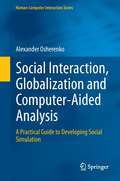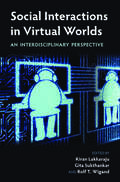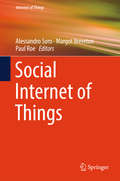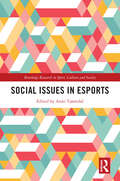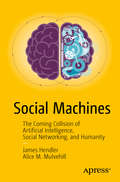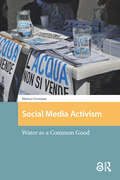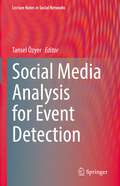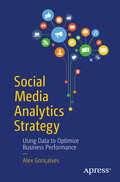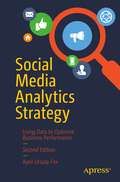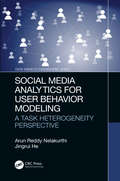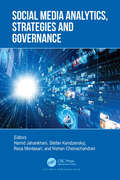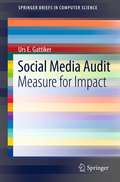- Table View
- List View
Social Informatics: 11th International Conference, SocInfo 2019, Doha, Qatar, November 18–21, 2019, Proceedings (Lecture Notes in Computer Science #11864)
by Emilio Zagheni Fabian Flöck Ingmar Weber Kareem M. Darwish Claudia Wagner Laura Nelson Samin ArefThis volume constitutes the proceedings of the 11th International Conference on Social Informatics, SocInfo 2019, held in Doha, Qatar, in November 2019. The 17 full and 5 short papers presented in these proceedings were carefully reviewed and selected from 86 submissions. The papers presented in this volume cover a broad range of topics, ranging from the study of socio-technical systems, to computer science methods to analyze complex social processes, as well as social concepts in the design of information systems.
Social Informatics: 12th International Conference, SocInfo 2020, Pisa, Italy, October 6–9, 2020, Proceedings (Lecture Notes in Computer Science #12467)
by Dino Pedreschi Frank Dignum Kalina Bontcheva Samin Aref Marco Braghieri Fosca Giannotti Francesco GrisoliaThis volume constitutes the proceedings of the 12th International Conference on Social Informatics, SocInfo 2020, held in Pisa, Italy, in October 2020. The 30 full and 3 short papers presented in these proceedings were carefully reviewed and selected from 99 submissions. The papers presented in this volume cover a broad range of topics, ranging from works that ground information-system design on social concepts, to papers that analyze complex social systems using computational methods, or explore socio-technical systems using social sciences methods.
Social Informatics: 13th International Conference, SocInfo 2022, Glasgow, UK, October 19–21, 2022, Proceedings (Lecture Notes in Computer Science #13618)
by Frank Hopfgartner Philipp Mayr Joemon Jose Kokil Jaidka Jan BreitsohlThis book constitutes the refereed proceedings of the 13th International Conference on Social Informatics, SocInfo 2022, which took place in Glasgow, UK, during October 19-21, 2022. The 22 full papers, 8 short papers, and 4 late breaking papers included in this book were carefully reviewed and selected from 102 submissions. The deal with topics ranging from information-system design on social concepts to analyzing complex social systems using computational methods or explore socio-technical techniques using social sciences methods.
Social Informatics: 8th International Conference, SocInfo 2016, Bellevue, WA, USA, November 11-14, 2016, Proceedings, Part I (Lecture Notes in Computer Science #10046)
by Emma Spiro and Yong-Yeol AhnThe two-volume set LNCS 10046 and 10047 constitutes the proceedings of the 8th International Conference on Social Informatics, SocInfo 2016, held in Bellevue, WA, USA, in November 2016. The 36 full papers and 39 poster papers presented in this volume were carefully reviewed and selected from 120 submissions. They are organized in topical sections named: networks, communities, and groups; politics, news, and events; markets, crowds, and consumers; and privacy, health, and well-being.
Social Informatics: 8th International Conference, SocInfo 2016, Bellevue, WA, USA, November 11-14, 2016, Proceedings, Part II (Lecture Notes in Computer Science #10047)
by Emma Spiro and Yong-Yeol AhnThe two-volume set LNCS 10046 and 10047 constitutes the proceedings of the 8th International Conference on Social Informatics, SocInfo 2016, held in Bellevue, WA, USA, in November 2016. The 33 full papers and 34 poster papers presented in this volume were carefully reviewed and selected from 120 submissions. They are organized in topical sections named: networks, communities, and groups; politics, news, and events; markets, crowds, and consumers; and privacy, health, and well-being.
Social Information Access: Systems And Technologies (Lecture Notes in Computer Science #10100)
by Peter Brusilovsky Daqing HeSocial information access is defined as a stream of research that explores methods for organizing the past interactions of users in a community in order to provide future users with better access to information. Social information access covers a wide range of different technologies and strategies that operate on a different scale, which can range from a small closed corpus site to the whole Web.The 16 chapters included in this book provide a broad overview of modern research on social information access. In order to provide a balanced coverage, these chapters are organized by the main types of information access (i.e., social search, social navigation, and recommendation) and main sources of social information.
Social Intelligence: The New Frontier of Integrating Human Intelligence and Artificial Intelligence in Social Space
by Yang Zhang Dong Wang Lanyu ShangGiven the rise of AI and the advent of online collaboration opportunities (e.g., social media, crowdsourcing), emerging research has started to investigate the integration of AI and human intelligence, especially in a collaborative social context. This creates unprecedented challenges and opportunities in the field of Social Intelligence (SI), where the goal is to explore the collective intelligence of both humans and machines by understanding their complementary strengths and interactions in the social space. In this book, a set of novel human-centered AI techniques are presented to address the challenges of social intelligence applications, including multimodal approaches, robust and generalizable frameworks, and socially empowered explainable AI designs. The book then presents several human-AI collaborative learning frameworks that jointly integrate the strengths of crowd wisdom and AI to address the limitations inherent in standalone solutions. The book also emphasizes pressing societal issues in the realm of social intelligence, such as fairness, bias, and privacy. Real-world case studies from different applications in social intelligence are presented to demonstrate the effectiveness of the proposed solutions in achieving substantial performance gains in various aspects, such as prediction accuracy, model generalizability and explainability, algorithmic fairness, and system robustness.
Social Interaction, Globalization and Computer-Aided Analysis
by Alexander OsherenkoTackling globalization is a great challenge - it is both extremely beneficial and essentially problematic. This comprehensive, multidisciplinary study confronts this ambivalence through the use of computer simulation. It discusses the findings of social interaction and social simulation through the use of understandable global examples. Readers can use this book as a tool to outline significant aspects of intercultural simulation and highlight the issues that need to be considered in the reader's analysis. The author leads the reader via sequential narration from a colloquial description of intercultural situations to final simulation prototypes; each step is accompanied by descriptive comments and program code. Social Interaction, Globalization and Computer-aided Analysis shows the reader how to acquire intercultural data from seemingly inconceivable information sources. Researchers and software developers engaged in interdisciplinary research projects in the field of Human-Computer Interaction will find this book to be a useful companion in their work. Alexander Osherenko is the founder of the start-up company Socioware Development, which implements psychologically-, sociologically- and culturally-aware software that scrutinizes information based on the findings of the cognitive sciences. Solutions created by Socioware Development can be implemented across a vast spectrum of industries, including car manufacturing, insurance and banking, Internet search engines and e-retailers.
Social Interactions in Virtual Worlds: An Interdisciplinary Perspective
by Rolf T. Wigand Gita Sukthankar Kiran LakkarajuWithin the rapidly-growing arena of 'virtual worlds', such as Massively Multiplayer Online Games (MMOs), individuals behave in particular ways, influence one another, and develop complex relationships. This setting can be a useful tool for modeling complex social systems, cognitive factors, and interactions between groups and within organizations. To study these worlds effectively requires a cross-disciplinary approach that integrates social science theories with big data analytics. This broad-based book offers a comprehensive and holistic perspective on the field. It brings together research findings from an international team of experts in computer science (artificial intelligence, game design, and social computing), psychology, and the social sciences to help researchers and practitioners better understand the fundamental processes underpinning social behavior in virtual worlds such as World of Warcraft, Rift, Eve Online, and Travian.
Social Internet of Things (Internet of Things)
by Alessandro Soro Margot Brereton Paul RoeThe aim of this book is to stimulate research on the topic of the Social Internet of Things, and explore how Internet of Things architectures, tools, and services can be conceptualized and developed so as to reveal, amplify and inspire the capacities of people, including the socialization or collaborations that happen through or around smart objects and smart environments. From new ways of negotiating privacy, to the consequences of increased automation, the Internet of Things poses new challenges and opens up new questions that often go beyond the technology itself, and rather focus on how the technology will become embedded in our future communities, families, practices, and environment, and how these will change in turn.
Social Issues in Esports (Routledge Research in Sport, Culture and Society)
by Anne TjønndalThis book provides important new insights into social issues in the rapidly growing field of esports, filling a gap in the literature that has, until now, been dominated by business and management perspectives. Bringing together leading esports experts from Europe, North America and Australia, the book provides new sociological analyses that define and locate esports in social studies. It explores key issues in esports, and in the wider sociology of sport, including gender equity, diversity, cheating and doping, physical and mental health, and issues related to the governance of esports. Presenting new empirical research alongside critical, theoretical perspectives, the book addresses themes such as digitalisation, technology, equality, innovation and welfare, suggesting directions for future research and highlighting implications for practice and development in the esports industry. This is essential reading for advanced students, researchers and practitioners working in esports, the sociology of sport, gaming studies, media studies, sociology, or the interaction of ICT and wider society.
Social Justice, Media and Technology in Teacher Education: 27th ATEE Spring Conference, ATEE 2021, Florence, Italy, October 28–29, 2021, Revised Selected Papers (Communications in Computer and Information Science #1649)
by Maria Ranieri Marta Pellegrini Laura Menichetti Alice Roffi Damiana LuzziThis book constitutes the refereed proceedings of the 27th ATEE Spring Conference onSocial Justice, Media and Technology, ATEE 2021, held in Florence, Italy, during October 28–30, 2021.The 19 full papers included in this book were carefully reviewed and selected from 49 submissions. They were organized in topical sections as follows: teaching critical media/digital literacy in multicultural societies; decommodifying teacher (digital) education; and digital technology and equity for inclusive teaching.
Social Machines
by James Hendler Alice M. MulvehillWill your next doctor be a human being--or a machine? Will you have a choice? If you do, what should you know before making it? This book introduces the reader to the pitfalls and promises of artificial intelligence (AI) in its modern incarnation and the growing trend of systems to "reach off the Web" into the real world. The convergence of AI, social networking, and modern computing is creating an historic inflection point in the partnership between human beings and machines with potentially profound impacts on the future not only of computing but of our world and species. AI experts and researchers James Hendler--co-originator of the Semantic Web (Web 3. 0)--and Alice Mulvehill--developer of AI-based operational systems for DARPA, the Air Force, and NASA--explore the social implications of AI systems in the context of a close examination of the technologies that make them possible. The authors critically evaluate the utopian claims and dystopian counterclaims of AI prognosticators. Social Machines: The Coming Collision of Artificial Intelligence, Social Networking, and Humanity is your richly illustrated field guide to the future of your machine-mediated relationships with other human beings and with increasingly intelligent machines. What Readers Will Learn What the concept of a social machine is and how the activities of non-programmers are contributing to machine intelligence How modern artificial intelligence technologies, such as Watson, are evolving and how they process knowledge from both carefully produced information (such as Wikipedia and journal articles) and from big data collections The fundamentals of neuromorphic computing, knowledge graph search, and linked data, as well as the basic technology concepts that underlie networking applications such as Facebook and Twitter How the change in attitudes towards cooperative work on the Web, especially in the younger demographic, is critical to the future of Web applications Who This Book Is For General readers and technically engaged developers, entrepreneurs, and technologists interested in the threats and promises of the accelerating convergence of artificial intelligence with social networks and mobile web technologies.
Social Manufacturing: Fundamentals and Applications (Springer Series in Advanced Manufacturing)
by Pingyu JiangThis book introduces social manufacturing, the next generation manufacturing paradigm that covers product life cycle activities that deal with Internet-based organizational and interactive mechanisms under the context of socio-technical systems in the fields of industrial and production engineering. Like its subject, the book's approach is multi-disciplinary, including manufacturing systems, operations management, computational social sciences and information systems applications. It reports on the latest research findings regarding the social manufacturing paradigm, the architecture, configuration and execution of social manufacturing systems and more. Further, it describes the individual technologies enabled by social manufacturing for each topic, supported by case studies. The technologies discussed include manufacturing resource minimalization and their socialized reorganizations, blockchain models in cybersecurity, computing and decision-making, social business relationships and organizational networks, open product design, social sensors and extended cyber-physical systems, and social factory and inter-connections. This book helps engineers and managers in industry to practice social manufacturing, as well as offering a systematic reference resource for researchers in manufacturing. Students also benefit from the detailed discussions of the latest research and technologies that will have been put into practice by the time they graduate.
Social Marketing Superstars: Social Media Mystery to Mastery in 30 Days
by Cydney O'SullivanThe internet arrived with a boom changing the landscape for business and opening up a global marketplace like nothing before. The pace of change has been building with exponential momentum, the impact has hit, and the game has changed. Businesses all over the world are asking two big questions. How do we adapt while protecting our brand, assets & Intellectual Property? How do we incorporate the new technologies, mobility and social media into our business? Cydney O’Sullivan has spent the last decade working with business owners grappling with the challenges of taking their business online. She knew there had to be a better way, and sought out the success stories. Cydney interviews 30 forward thinking CEO’s and entrepreneurs who have built large, profitable communities using the technologies and networks we’ve all been grappling with like Google, Facebook, LinkedIn, Twitter, Youtube, eCommerce and Loyalty Programs. Learn how these seasoned entrepreneurs from around the world have adapted and applied technologies to become experts in their fields; many have created profits faster, more efficiently and more predictably than ever before in their businesses, as you answer these questions for your own business. What IS Social Marketing? Where does it fit in our business? How do we protect our Brand and Intellectual Property? How can we prepare our business for the future? With their success, for most of these entrepreneurs comes the opportunity to share this wealth of knowledge and experience to create a positive impact with their influence. This is the flame that fuels their entrepreneurial spirit beyond the quest for financial success alone.
Social Media
by Ralf LeinemannDie Beiträge aus unterschiedlichen Unternehmen bieten eine fundierte Darstellung zum Einfluss sozialer Medien (Facebook, Twitter, LinkedIn, Xing, etc) auf die Kommunikation und Aussendarstellung von Unternehmen sowie auf interne Prozesse. Die Autoren erläutern zunächst den Einfluss auf interne und externe Kommunikation, die Kommunikationsqualität in sozialen Medien und die Chancen und Risiken der neuen Medien. Die Einflüsse auf die verschiedenen Unternehmensbereiche werden aus der Praxis heraus diskutiert. Zu den adressierten Bereichen gehören die Auswirkungen auf PR und Analyst Relations sowie auf Kommunikation und IT-Infrastruktur. In zwei abschließenden Kapiteln werden auch einzelne Branchen beleuchtet und ein internationaler Vergleich vorgestellt.
Social Media Activism: Water as a Common Good (Protest and Social Movements)
by Matteo CernisonThis book focuses on the referendums against water privatization in Italy and explores how activists took to social media, ultimately convincing twenty-seven million citizens to vote. Investigating the relationship between social movements and internet-related activism during complex campaigns, this book examines how a technological evolution — the increased relevance of social media platforms — affected in very different ways organizations with divergent characteristics, promoting at the same time decentralized communication practices, and new ways of coordinating dispersed communities of people. Matteo Cernison combines and adapts a wide set of methods, from social network analysis to digital ethnography, in order to explore in detail how digital activism and face-to-face initiatives interact and overlap. He argues that the geographical scale of actions, the role played by external media professionals, and the activists’ perceptions of digital technologies are key elements that contribute in a significant way to shape the very different communication practices often described as online activism.
Social Media Analysis for Event Detection (Lecture Notes in Social Networks)
by Tansel ÖzyerThis book includes chapters which discuss effective and efficient approaches in dealing with various aspects of social media analysis by using machine learning techniques from clustering to deep learning. A variety of theoretical aspects, application domains and case studies are covered to highlight how it is affordable to maximize the benefit of various applications from postings on social media platforms. Social media platforms have significantly influenced and reshaped various social aspects. They have set new means of communication and interaction between people, turning the whole world into a small village where people with internet connect can easily communicate without feeling any barriers. This has attracted the attention of researchers who have developed techniques and tools capable of studying various aspects of posts on social media platforms with main concentration on Twitter. This book addresses challenging applications in this dynamic domain where it is not possible to continue applying conventional techniques in studying social media postings. The content of this book helps the reader in developing own perspective about how to benefit from machine learning techniques in dealing with social media postings and how social media postings may directly influence various applications.
Social Media Analytics Strategy
by Alex GonçalvesThis book shows you how to use social media analytics to optimize your business performance. The tools discussed will prepare you to create and implement an effective digital marketing strategy. From understanding the data and its sources to detailed metrics, dashboards, and reports, this book is a robust tool for anyone seeking a tangible return on investment from social media and digital marketing. Social Media Analytics Strategy speaks to marketers who do not have a technical background and creates a bridge into the digital world. Comparable books are either too technical for marketers (aimed at software developers) or too basic and do not take strategy into account. They also lack an overview of the entire process around using analytics within a company project. They don’t go into the everyday details and also don’t touch upon common mistakes made by marketers. This book highlights patterns of common challenges experienced by marketers from entry level to directors and C-level executives. Social media analytics are explored and explained using real-world examples and interviews with experienced professionals and founders of social media analytics companies. What You’ll Learn Get a clear view of the available data for social media marketing and how to access all of itMake use of data and information behind social media networks to your favorKnow the details of social media analytics tools and platforms so you can use any tool in the marketApply social media analytics to many different real-world use casesObtain tips from interviews with professional marketers and founders of social media analytics platformsUnderstand where social media is heading, and what to expect in the future Who This Book Is For Marketing professionals, social media marketing specialists, analysts up to directors and C-level executives, marketing students, and teachers of social media analytics/social media marketing
Social Media Analytics Strategy: Using Data to Optimize Business Performance
by April Ursula FoxThis book shows you how to use social media analytics to optimize your business performance. The tools discussed will prepare you to create and implement an effective digital marketing strategy. From understanding the data and its sources to detailed metrics, dashboards, and reports, this book is a robust tool for anyone seeking a tangible return on investment from social media and digital marketing. Social Media Analytics Strategy speaks to marketers who do not have a technical background and creates a bridge into the digital world. Comparable books are either too technical for marketers (aimed at software developers) or too basic and do not take strategy into account. They also lack an overview of the entire process around using analytics within a company project. They don’t go into the everyday details and also don’t touch upon common mistakes made by marketers. This book highlights patterns of common challenges experienced by marketers from entry level to directors and C-level executives. Social media analytics are explored and explained using real-world examples and interviews with experienced professionals and founders of social media analytics companies. What You’ll Learn Get a clear view of the available data for social media marketing and how to access all of itMake use of data and information behind social media networks to your favorKnow the details of social media analytics tools and platforms so you can use any tool in the marketApply social media analytics to many different real-world use casesObtain tips from interviews with professional marketers and founders of social media analytics platformsUnderstand where social media is heading, and what to expect in the future Who This Book Is For Marketing professionals, social media marketing specialists, analysts up to directors and C-level executives, marketing students, and teachers of social media analytics/social media marketing
Social Media Analytics for User Behavior Modeling: A Task Heterogeneity Perspective (Data-Enabled Engineering)
by Arun Reddy Nelakurthi Jingrui HeWinner of the "Outstanding Academic Title" recognition by Choice for the 2020 OAT Awards. The Choice OAT Award represents the highest caliber of scholarly titles that have been reviewed by Choice and conveys the extraordinary recognition of the academic community. In recent years social media has gained significant popularity and has become an essential medium of communication. Such user-generated content provides an excellent scenario for applying the metaphor of mining any information. Transfer learning is a research problem in machine learning that focuses on leveraging the knowledge gained while solving one problem and applying it to a different, but related problem. Features: Offers novel frameworks to study user behavior and for addressing and explaining task heterogeneity Presents a detailed study of existing research Provides convergence and complexity analysis of the frameworks Includes algorithms to implement the proposed research work Covers extensive empirical analysis Social Media Analytics for User Behavior Modeling: A Task Heterogeneity Perspective is a guide to user behavior modeling in heterogeneous settings and is of great use to the machine learning community.
Social Media Analytics, Strategies and Governance
by Hamid JahankhaniSocial media has spread rapidly on the global stage, driving consumers’ attention and influence, both consciously and subconsciously. Whilst this type of platform may have been initially designed as a tool for open communication and expression, it is also being utilized as a digital tool, with widescale use cases. The intelligence explosion, information overload and disinformation play a significant part regarding individual, group and country perceptions. The complex nature of this data explosion created an increasing demand and use of artificial intelligence (AI) and machine learning (ML), to help provide ‘big insights’ to ‘big data’. AI and ML enable the analysis and dissemination of vast amounts of data, however the ungoverned pace at which AI and autonomous systems have been deployed, has created unforeseen problems. Many algorithms and AI systems have been trained on limited or unverified datasets, creating inbuilt and unseen biases. Where these algorithmic tools have been deployed in high impact systems, there are documented occurrences of disastrous decision making and outcomes that have negatively impacted people and communities. Little to no work had been conducted in its vulnerability and ability to exploit AI itself. So, AI and autonomous systems, whilst being a force for societal good, could have the potential to create and exacerbate societies greatest challenges. This is a cohesive volume that addresses challenging problems and presents a range of innovative approaches and discussion.
Social Media Archeology and Poetics
by Judy MalloyFocusing on early social media in the arts and humanities and on the core role of creative computer scientists, artists, and scholars in shaping the pre-Web social media landscape, Social Media Archeology and Poetics documents social media lineage, beginning in the 1970s with collaborative ARPANET research, Community Memory, PLATO, Minitel, and ARTEX and continuing into the 1980s and beyond with the Electronic Café, Art Com Electronic Network, Arts Wire, The THING, and many more.With first person accounts from pioneers in the field, as well as papers by artists, scholars, and curators, Social Media Archeology and Poetics documents how these platforms were vital components of early social networking and important in the development of new media and electronic literature. It describes platforms that allowed artists and musicians to share and publish their work, community networking diversity, and the creation of footholds for the arts and humanities online. Anditinvites comparisons of social media in the past and present, asking: What can we learn from early social media that will inspire us to envision a greater cultural presence on contemporary social media?ContributorsMadeline Gonzalez Allen, James Blustein, Hank Bull, Annick Bureaud, J. R. Carpenter, Paul E. Ceruzzi, Anna Couey, Amanda McDonald Crowley, Steve Dietz, Judith Donath, Steven Durland, Lee Felsenstein, Susanne Gerber, Ann-Barbara Graff, Dene Grigar, Stacy Horn, Antoinette LaFarge, Deena Larsen, Gary O. Larson, Alan Liu, Geert Lovink, Richard Lowenberg, Judy Malloy, Scott McPhee, Julianne Nyhan, Howard Rheingold, Randy Ross, Wolfgang Staehle, Fred Truck, Rob Wittig, David R. Woolley
Social Media Archeology and Poetics (Leonardo)
by Judy MalloyFirst person accounts by pioneers in the field, classic essays, and new scholarship document the collaborative and creative practices of early social media.Focusing on early social media in the arts and humanities and on the core role of creative computer scientists, artists, and scholars in shaping the pre-Web social media landscape, Social Media Archeology and Poetics documents social media lineage, beginning in the 1970s with collaborative ARPANET research, Community Memory, PLATO, Minitel, and ARTEX and continuing into the 1980s and beyond with the Electronic Café, Art Com Electronic Network, Arts Wire, The THING, and many more.With first person accounts from pioneers in the field, as well as papers by artists, scholars, and curators, Social Media Archeology and Poetics documents how these platforms were vital components of early social networking and important in the development of new media and electronic literature. It describes platforms that allowed artists and musicians to share and publish their work, community networking diversity, and the creation of footholds for the arts and humanities online. And it invites comparisons of social media in the past and present, asking: What can we learn from early social media that will inspire us to envision a greater cultural presence on contemporary social media?ContributorsMadeline Gonzalez Allen, James Blustein, Hank Bull, Annick Bureaud, J. R. Carpenter, Paul E. Ceruzzi, Anna Couey, Amanda McDonald Crowley, Steve Dietz, Judith Donath, Steven Durland, Lee Felsenstein, Susanne Gerber, Ann-Barbara Graff, Dene Grigar, Stacy Horn, Antoinette LaFarge, Deena Larsen, Gary O. Larson, Alan Liu, Geert Lovink, Richard Lowenberg, Judy Malloy, Scott McPhee, Julianne Nyhan, Howard Rheingold, Randy Ross, Wolfgang Staehle, Fred Truck, Rob Wittig, David R. Woolley
Social Media Audit
by Urs E. GattikerSocial media has drastically improved the way we can reach target audiences and serve our customers. Like its financial counterpart, the social media audit (SMA) can be described as a formalized review of anorganization's social media activities. However, contrary to financial audits, social media audits are not guided by government regulations or a set of professional rules and standards. This book will address social media marketing issues using a cost benefit approach, while presenting a systematic approach to review the organization's social media activities. Using the checklists and templates provided in this book will enable readers to conduct an audit that helps identify target areas for performance improvement and recommendations for how to achieve these objectives. Social media platforms discussed include: Facebook, LinkedIn, Google Plus, Twitter, Tumblr, and Xing.
